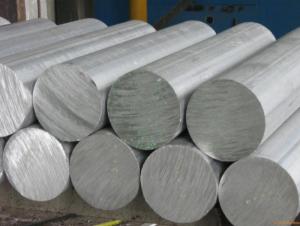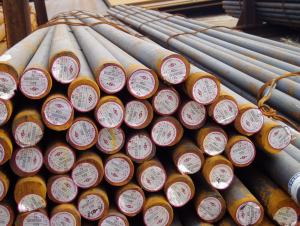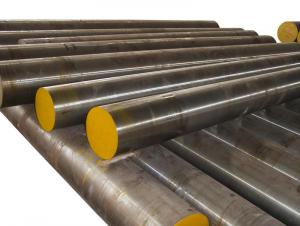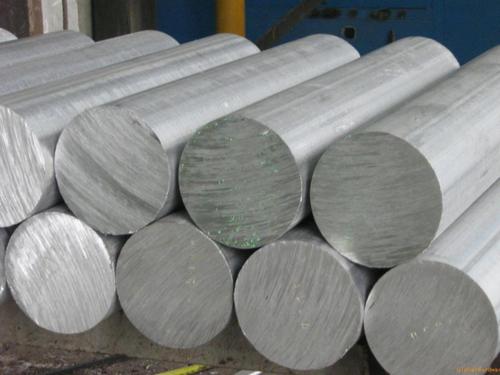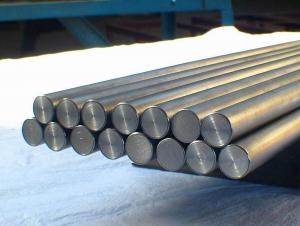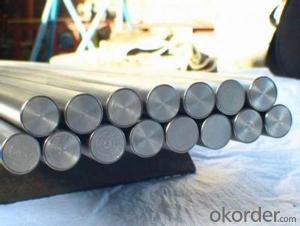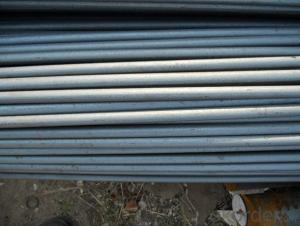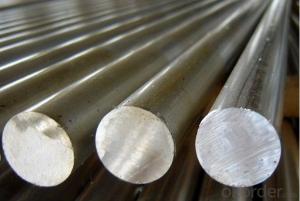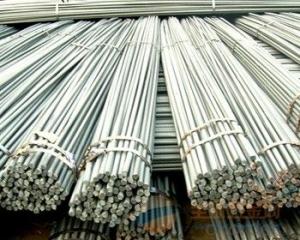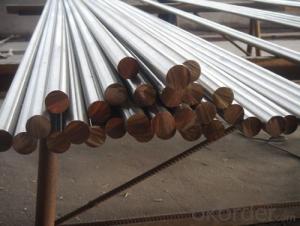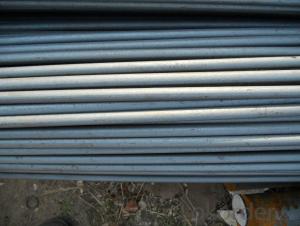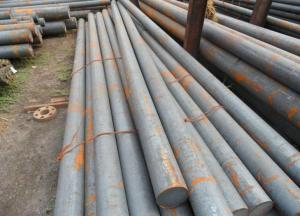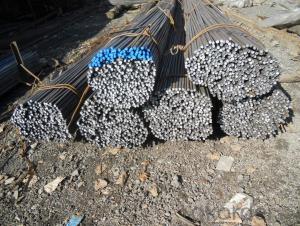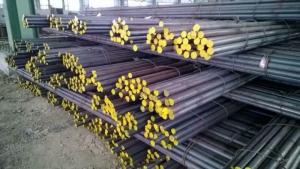hot rolled Round BAR
- Loading Port:
- China Main Port
- Payment Terms:
- TT OR LC
- Min Order Qty:
- -
- Supply Capability:
- -
OKorder Service Pledge
OKorder Financial Service
You Might Also Like
used in construction and a large number of architectural and engineering structures.
4. Some special round bar can be used for automotive engine and transmission components, bearing, rails machine tools and wire rope.
Packaging & Delivery of American Standard Round Bar
Packaging Detail: All goods are packed in bundle with steel strips and shipped by break bulk vessel or container (depend on target market and different ports)
Delivery Detail: 45 days
Trade terms: FOB, CFR, CIF
MOQ: 25 tons per specification; we can negotiate the quantity if the specification is normal or we have stock of one specification.
Weight: Theprice invoicing on theoretical weight basis or actual weight basis depends on customer’s request.
Shipment: The shipment of bulk break or container is depends on customer’s request and the situation of the port of destination.
Documents given: Full set of original clean on board bill of lading; Original signed commercial invoice; Original packing list; Policy of insurance; Certificate of origin and what the target market needs.
Production Flow of American Standard Round Bar
The common processes are preheated forging quenching, dual refinement solution process, cooling quenching and isothermal quenching. We use heat treatment for dual refinement solution process.
Quality Assurance of American Standard Round Bar
1. We will strictly inspect our production that we sold according to the customer’s request.
2. Quality should be in conformity with the specification of the manufacturer. Quantity and packing conditions should be in conformity with the term in the contract.
3. Should the packing found damaged, the buyer has the right to claim to the seller.
- Q: Can steel round bars be used in the production of springs?
- Certainly! Springs can be produced using steel round bars. Steel is a commonly chosen material for manufacturing springs because it possesses strong attributes and excellent durability. Steel round bars are frequently employed as the foundation material for springs because they can be easily manipulated and formed into the desired spring shape. Moreover, by subjecting steel round bars to heat treatment, their mechanical properties can be improved, rendering them appropriate for a range of spring applications. The selection of steel type relies on the desired characteristics and requirements of the spring, such as the desired level of flexibility and resistance to deformation. In summary, steel round bars are extensively employed in spring production due to their outstanding mechanical properties, making them a suitable option for a variety of spring applications.
- Q: What are the different types of surface defects that can occur in steel round bars?
- There are several types of surface defects that can occur in steel round bars. Some of the most common defects include: 1. Scratches: These are shallow grooves or marks on the surface of the round bar caused by friction or contact with sharp objects during handling or transport. 2. Pitting: Pits are small, localized cavities or depressions on the surface of the round bar caused by corrosion or exposure to harsh environments. Pitting can lead to further corrosion if not addressed. 3. Scale: Scale refers to the thin layer of oxide or other impurities that can form on the surface of steel round bars during the manufacturing process. It can affect the appearance and quality of the bar but is often removed during subsequent processing or cleaning. 4. Scabs: Scabs are irregularly shaped protrusions or raised areas on the surface of the round bar caused by solidification or cooling issues during the casting process. They can reduce the strength and integrity of the bar if not properly addressed. 5. Roll marks: These are elongated depressions or ridges on the surface of the round bar caused by uneven or improper rolling during the manufacturing process. Roll marks can affect the dimensional accuracy of the bar and may require additional processing or grinding to remove. 6. Laminations: Laminations are internal defects that can sometimes be visible on the surface of the round bar. They are caused by improper bonding or separation of layers during the steelmaking process. Laminations can weaken the bar and reduce its load-bearing capacity. 7. Inclusions: Inclusions are non-metallic particles or impurities that can become trapped in the steel during the manufacturing process. They can appear as dark spots or irregularities on the surface of the round bar and may affect its mechanical properties. It is important to note that these surface defects can vary in severity and impact on the performance of the steel round bar. Manufacturers and quality control personnel employ various inspection techniques to identify and mitigate these defects to ensure the quality and reliability of the final product.
- Q: How do you check the quality of a steel round bar?
- Several factors need to be taken into account when checking the quality of a steel round bar. Firstly, it is crucial to assess the dimensions of the bar. This involves measuring its diameter, length, and straightness. Any deviation from the specified dimensions could indicate a lower quality bar. Next, it is important to inspect the surface condition of the steel round bar. It should be free from visible defects such as cracks, pits, or surface irregularities. Additionally, the surface should be smooth and without significant roughness or burrs. Moreover, the chemical composition of the steel round bar must be examined. This can be done through spectroscopic analysis or other testing methods. The composition should meet the required standards and specifications, as any deviations can impact the bar's strength and durability. Another crucial aspect to consider is the mechanical properties of the steel round bar. This involves testing its tensile strength, yield strength, and elongation. Specialized machines can be used for these tests to ensure that the bar meets the necessary strength requirements. Additionally, non-destructive testing methods such as ultrasonic testing or magnetic particle inspection can be employed to identify any internal or surface defects that may affect the bar's quality. Furthermore, it is essential to verify the bar's compliance with industry standards and certifications. This includes checking if the steel round bar meets the specifications set by organizations like ASTM International or ISO. Lastly, consulting reputable suppliers or manufacturers with a proven track record in producing high-quality steel round bars is advisable. They can provide documentation, certifications, and test reports to validate the quality of their products. To summarize, evaluating the dimensions, surface condition, chemical composition, mechanical properties, compliance with standards, and supplier's reputation are key steps in checking the quality of a steel round bar. By thoroughly examining these factors, one can ensure the reliability and performance of the steel round bar for its intended applications.
- Q: Are steel round bars available in custom lengths?
- Yes, steel round bars are available in custom lengths. Steel round bars are typically manufactured in standard lengths, but many suppliers offer the option to cut them to specific lengths according to customer requirements. This allows for greater flexibility in various applications where precise lengths are needed. Whether you need shorter or longer steel round bars, you can contact a steel supplier or fabricator who can assist you in obtaining custom lengths that meet your project's specifications.
- Q: Can steel round bars be used in the packaging industry?
- Yes, steel round bars can be used in the packaging industry. They are commonly used for constructing pallets, crates, and other packaging materials that require strength, durability, and load-bearing capacity. Steel round bars provide a robust and reliable solution for packaging heavy and bulky items, ensuring safe transportation and storage.
- Q: How do you calculate the strength of a steel round bar?
- When calculating the strength of a steel round bar, several factors come into play. The primary consideration is the yield strength of the material, which signifies the stress level at which the steel permanently deforms. This value is typically provided by the manufacturer or can be found in engineering handbooks. The next step involves determining the cross-sectional area of the round bar. This can be achieved by measuring the bar's diameter and utilizing it to calculate the area using the formula A = πr^2, where A represents the cross-sectional area and r denotes the radius. Once the cross-sectional area is established, it becomes possible to calculate the ultimate tensile strength (UTS) using the formula UTS = Yield Strength / Safety Factor. The safety factor is a numerical value that takes into account uncertainties and potential variations in the material's strength. It is usually specified by design requirements or industry standards. Lastly, the maximum load that the steel round bar can endure before failing can be determined by multiplying the ultimate tensile strength by the cross-sectional area. This value represents the bar's strength and can be utilized to evaluate its suitability for a specific application. It is worth noting that other factors, such as the bar's length, shape, and any additional treatments or modifications, can also impact its strength. Therefore, it is recommended to consult with a structural engineer or refer to relevant design codes and standards to ensure accurate calculations and safe application of steel round bars.
- Q: Can the same grade steel instead of round bar be ok?
- Physical and mechanical properties are different. Because of the different chemical composition and strength of reinforcing steel, they are different in physical and mechanical properties. The cold bending property of steel is good, can make the hook 180, screw steel can only make straight hook 90 degrees; steel weldability is good, with ordinary carbon steel electrode can be used to low alloy electrode; anti fatigue performance and toughness in steel bar is good.
- Q: What is the minimum diameter available for steel round bars?
- The specific manufacturing and supplier capabilities can cause variations in the minimum diameter of available steel round bars. Typically, a wide range of diameters can be found, starting from as small as 1/8 inch (3.175 mm) and going up to several inches or even larger. To ascertain the exact minimum diameter for steel round bars that aligns with your specific needs, it is advisable to consult with steel suppliers or manufacturers.
- Q: How do I calculate the length of a steel round bar based on weight?
- In order to determine the length of a steel round bar based on its weight, there are a few factors to consider. Firstly, you must be aware of the density of steel, which typically ranges around 7850 kilograms per cubic meter. However, it's worth noting that this value can vary depending on the specific type and grade of steel being utilized. After obtaining the density value, the next step involves converting the weight of the steel round bar into kilograms if it is initially given in a different unit. For instance, if the weight is provided in pounds, you can multiply it by 0.4536 to convert it into kilograms. Once you have successfully converted the weight into kilograms, you can proceed with using the following formula to calculate the length: Length = Weight / (Density * π * (Diameter/2)^2) It's important to ensure that the diameter is measured in meters. If the diameter is given in a different unit, it must be converted accordingly. Additionally, the symbol "π" represents the mathematical constant pi, which is approximately equal to 3.14159. By substituting the appropriate values into the formula, you will be able to accurately determine the length of the steel round bar. Remember to maintain consistent units throughout the calculation to yield precise results. Please bear in mind that this calculation assumes the round bar possesses a consistent diameter along its entire length. If the bar exhibits varying diameters or irregularities, the resulting length may be an approximation rather than an exact measurement.
- Q: Can steel round bars be used in the manufacturing of machinery?
- Yes, steel round bars can definitely be used in the manufacturing of machinery. Steel round bars are widely used in various industries for their strength, durability, and versatility. They are commonly used to create components such as shafts, axles, gears, and other mechanical parts that require high strength and resistance to wear and tear. Steel round bars offer excellent mechanical properties, including high tensile strength and good machinability, which make them suitable for use in heavy machinery and equipment. Additionally, steel round bars can be easily welded, forged, or machined into the desired shape, making them a preferred choice for manufacturing machinery.
Send your message to us
hot rolled Round BAR
- Loading Port:
- China Main Port
- Payment Terms:
- TT OR LC
- Min Order Qty:
- -
- Supply Capability:
- -
OKorder Service Pledge
OKorder Financial Service
Similar products
Hot products
Hot Searches
Related keywords
